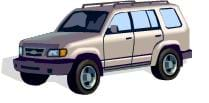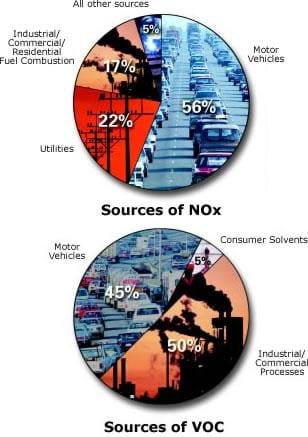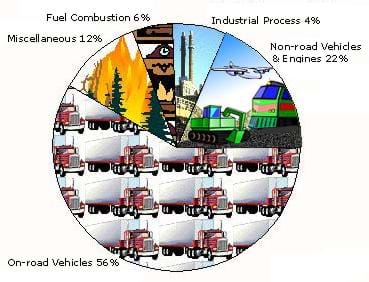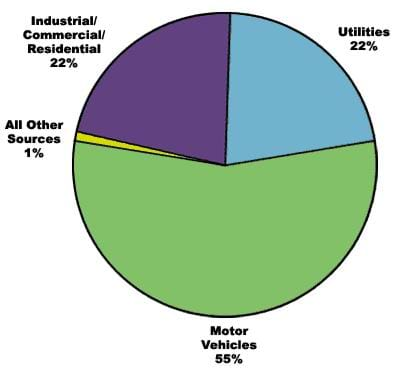Quick Look
Grade Level: 4 (3-5)
Time Required: 15 minutes
Lesson Dependency: None
Subject Areas: Measurement, Physical Science, Problem Solving, Science and Technology
NGSS Performance Expectations:

| 4-ESS3-1 |

Summary
Looking at transportation and the environment, students learn that some human-made creations, such as vehicles, can harm the natural environment. They also learn about alternative fuels and vehicles designed by engineers to minimize pollution. The associated hands-on activity gives students a chance to design their own eco-friendly vehicles.Engineering Connection
Engineers design and build many different things that benefit society. Unfortunately, some of these designs lead to the release of pollution into the environment. Pollution can have a negative effect on the health of humans and the environment and even cause deterioration of national landmarks. Environmental engineers specialize in cleaning up and minimizing the amount of pollution that is emitted to assure clean air and water for the population. Many different types of engineers work together to explore options of how to make daily processes, such as driving a vehicle, cleaner and better for the environment.
Learning Objectives
After this lesson, students should be able to:
- Explain that cars are a major contributor to air pollution.
- Understand that alternative forms of transportation and new types of cars can produce fewer harmful emissions.
- Explain that environmental engineers focus on keeping air and water clean for humans and to protect the environment.
- Name two renewable energy sources.
Educational Standards
Each TeachEngineering lesson or activity is correlated to one or more K-12 science,
technology, engineering or math (STEM) educational standards.
All 100,000+ K-12 STEM standards covered in TeachEngineering are collected, maintained and packaged by the Achievement Standards Network (ASN),
a project of D2L (www.achievementstandards.org).
In the ASN, standards are hierarchically structured: first by source; e.g., by state; within source by type; e.g., science or mathematics;
within type by subtype, then by grade, etc.
Each TeachEngineering lesson or activity is correlated to one or more K-12 science, technology, engineering or math (STEM) educational standards.
All 100,000+ K-12 STEM standards covered in TeachEngineering are collected, maintained and packaged by the Achievement Standards Network (ASN), a project of D2L (www.achievementstandards.org).
In the ASN, standards are hierarchically structured: first by source; e.g., by state; within source by type; e.g., science or mathematics; within type by subtype, then by grade, etc.
NGSS: Next Generation Science Standards - Science
| NGSS Performance Expectation | ||
|---|---|---|
|
4-ESS3-1. Obtain and combine information to describe that energy and fuels are derived from natural resources and their uses affect the environment. (Grade 4) Do you agree with this alignment? |
||
| Click to view other curriculum aligned to this Performance Expectation | ||
| This lesson focuses on the following Three Dimensional Learning aspects of NGSS: | ||
| Science & Engineering Practices | Disciplinary Core Ideas | Crosscutting Concepts |
| Obtain and combine information from books and other reliable media to explain phenomena. Alignment agreement: | Energy and fuels that humans use are derived from natural sources, and their use affects the environment in multiple ways. Some resources are renewable over time, and others are not. Alignment agreement: | Cause and effect relationships are routinely identified and used to explain change. Alignment agreement: Knowledge of relevant scientific concepts and research findings is important in engineering.Alignment agreement: Over time, people's needs and wants change, as do their demands for new and improved technologies.Alignment agreement: |
International Technology and Engineering Educators Association - Technology
-
The use of technology affects the environment in good and bad ways.
(Grades
3 -
5)
More Details
Do you agree with this alignment?
-
The use of transportation allows people and goods to be moved from place to place.
(Grades
3 -
5)
More Details
Do you agree with this alignment?
State Standards
Colorado - Science
-
Use multiple resources – including print, electronic, and human – to locate information about different sources of renewable and nonrenewable energy
(Grade
4)
More Details
Do you agree with this alignment?
Introduction/Motivation
The day has arrived for your class to board a plane and head to Beijing for the Olympics! Some of your classmates are a bit nervous about the long flight, but your teacher assures you that the plane has been very well engineered and is a safe mode of transportation.
What kind of engineers would be involved in making airplanes? Think about all the different elements of airplanes: the airplane itself, the hydraulic lift for the wheels, the lights, the computers and even the control of the cabin temperature. With all these different elements, we can see that an airplane is the result of combined efforts from many different types of engineers. Aerospace engineers design the body; materials engineers choose the materials; mechanical engineers design the engine and the landing gear; electrical engineers design the inside and outside lights and air conditioning system; and computer engineers design the plane's navigational system and communication system. Wow, how many was that? Yes, at least five types of engineers are involved in the design and construction of an airplane.
After everyone is in their places with their seatbelts fastened, the pilot announces that the plane is ready for take off! You count down as the plane taxis for take off, and 5, 4, 3, 2, 1 – you are airborne! The plane shudders as it slices through the different layers of the atmosphere, and you stare out the window in amazement as your flight becomes smooth and you glide effortlessly across the sky. Flying is truly incredible, you think.
During the flight you and your friends continue to talk about how airplanes are made. This discussion gets you thinking about all the other different modes of transport.
What are the different kinds of transportation? (List other forms of transportation on the board: cars, trains, bicycles, motorcycles, boats, etc.) Can anyone think of any alternative modes of transport? Hybrids are an alternative mode of transportation and biodiesel is an alternative fuel. Does anyone know about biodiesel? Biodiesel is an alternative to regular diesel that burns much cleaner and pollutes the air less than regular gasoline. It is usually made from soybeans, and some people say that the exhaust from biodiesel vehicles smells like French fries! Right now, the emissions from regular automobiles are one of the main sources of pollution, emitting 4 of the top 6 pollutants, as identified by the U.S. Environmental Protection Agency (EPA). Pollution from cars contributes to the formation of smog — a sometimes severe problem in many big cities, such as Los Angeles. However, engineers have designed different kinds of vehicles which produce fewer harmful emissions. As a class, let's discuss these new types of motorized vehicles that are known for being "green." These vehicles include hybrids, electric vehicles, low emission vehicles, vehicles that run on biodiesel, and scooters. Why do you think it's important to reduce emissions from cars? And, why is it important to save the environment? Saving the environment is crucial for long term human and environmental health. Can anyone think of some things that we can do that will help save our environment and help keep it clean? One way that we can help preserve the environment is to use renewable energy sources. Oil is a limited resource which is burned for energy and is not renewable. Can anyone think of renewable sources of energy that are better for the environment than oil? These sources include solar, water and wind power, as well as biodiesel.
How many cars do you have in your family? Let's tally up the total number of cars for the entire class. Knowing how many cars there are total from this class, we are going to estimate how many cars are driven in our county. (Note: To help the students, find population data for the local county. It may help to use the following method: if we have 30 students in the class, and 45 cars, that's about 1.5 cars per person. So, if there are 100,000 people in our county, and we multiply 100,000 by 1.5, that would be about 150,000 cars for our whole county.)
Does this sound like a reasonable number to you? Going beyond our estimation of cars in our county, it is estimated that there are 600 million cars driven worldwide.
Let's continue thinking about different types of engineers. Which type of engineer most likely works on making the air and water cleaner? Actually, all kinds of engineers are now working to make cleaner burning machines; however, cleaning up air and water is the main focus of environmental engineers. Environmental engineers often organize and implement clean-up efforts after events such as an oil spill or when industrial sites close down. Why is the work that environmental engineers do so important? (Answer: because it helps people, animals and our environment stay clean and healthy)
Lesson Background and Concepts for Teachers
Pollution Types
The EPA has identified six common air pollutants: ozone, particulate matter, carbon monoxide, nitrogen dioxide, sulfur dioxide and lead. Automobiles and other modes of transport (buses, trucks, etc.) play a large role in the emissions of many of these types of dangerous pollution, emitting four of the six common pollutants into the environment. While environmental policies have helped to greatly reduce the amount of emissions per vehicle, the number of vehicles on the road, and the distance traveled per vehicle, have both greatly increased. Students can do their part to design the future of eco-friendly transport with the associated activity Cars from the Future: Presenting Your Eco-Friendly Design Ideas.
Ozone is composed of three molecules of oxygen, and its chemical formula is O3. Ozone can be "good" or "bad" depending on its location. "Good" ozone is located high in the atmosphere and protects the earth from damaging UV rays from the sun. This beneficial ozone layer is slowly being destroyed by human-made chemicals. A good example of this is found in the "ozone-hole" over the North and South Poles. "Bad" ozone is found lower in the Earth's atmosphere. It is created (see the equation below) when emissions from cars, power plants, industrial boilers, refineries, chemical plants, and other sources react chemically in the presence of sunlight. "Bad" ozone contributes to both environmental and human health problems.
bad ozone = volatile organic compounds + nitrogen oxides + sunlight
As illustrated in Figure 1, motor vehicles have an enormous impact on the formation of ozone by emitting nitrogen oxides (NOx) and volatile organic compounds (VOCs).

Particulate matter is what you see when there is haze or smog in the air. Particulate matter can either be directly emitted from vehicles, factories, farming activities and fires, or it can be the indirect result of burning fuels in the presence of sunlight and water vapor, such as fuel combustion in vehicles and power plants (see Figure 2). Particulate matter plays a huge role in health problems and also impacts the delicate chemical balance of eco-systems. Particulate matter is also responsible for the oftentimes permanent staining of statues and buildings.

Carbon monoxide (CO) is a gas that is released when fuel is not burned completely. Carbon monoxide is very dangerous to human health, and, ironically, more than one half of the CO emissions come from on-road vehicles. Other sources include non-road vehicles, such as trains and airplanes, industrial processes, fuel combustion and miscellaneous sources, such as forest fires. The breakdown of percentages of CO contribution to our environment is shown in Figure 3. Carbon monoxide, an organic compound, also contributes to the formation of ground level smog or ozone.

Nitrogen oxides (NOx) refers to a group of gasses that contain nitrogen and oxygen. They are one of the primary components of ozone, and the main source is, again, motor vehicles. NOx contributes to the formation of acid rain and deteriorates water quality. NOx emissions also contribute to atmospheric particles which cause respiratory problems and visibility impairment.

Sulfur dioxide (SO2) comes mainly from burning coal in large industrial processes, but also from trains and boats with coal-burning engines. Sulfur dioxide contributes to respiratory illness, acid rain and visibility impairment. Motor vehicles contribute 5% of sulfur dioxide emissions. The majority of lead pollution now comes from metal processing. However, in the 1970s, motor vehicles were responsible for almost 80% of lead pollution. Environmental laws leading to the removal of lead from gasoline have essentially eliminated on-road vehicle lead pollution.
Vehicle/Fuel Alternatives
As seen recently in the news media, alternative fuels and vehicles have been developed and are gaining mainstream popularity.
The main two types of alternative vehicles are hybrid and electric. The common hybrid vehicle is a gas-electric hybrid, utilizing both gas and electric engines to increase fuel efficiency and greatly decrease emissions. Electric vehicles rely solely on electric battery power to run the vehicle, which causes them to have no need for gasoline and very low emissions. Each vehicle has its limitations, though both show a movement towards decreasing vehicle emissions and taking responsibility for protecting our environment.
Biodiesel is an animal fat- or vegetable oil-based alternative fuel which has much lower emissions than regular unleaded or diesel fuels. Biodiesel is a sustainable and non-toxic resource that can be made locally and from recycled ingredients, such as vegetable (soybean) oil used at restaurants. These ingredients are processed at a refinery and turned into a fuel-grade product. Remember, you cannot just put vegetable oil into your vehicle's gas tank and expect it to run – that would definitely harm your car's engine.
Other possibilities for alternative vehicles in the future include increasing the efficiency of hybrids and ease of use of electrics as well as the development of hydrogen-powered cars. Hydrogen cars are close to zero emissions and use an infinitely renewable resource.
Clean Energy
Several methods of producing energy have less impact on the environment. Each method has its pros and cons. Some examples are:
Wind Turbines – Clean energy using wind power; limited by the amount of wind available. Solar Power – Clean energy using the sun; limited by weather (i.e., the number of sunny days or hours available); photovoltaic cells are still quite expensive.
Biodiesel – Fewer harmful emissions than regular gasoline or diesel; must have a diesel engine to use biodiesel, and gas stations selling biodiesel are still sparse in some states.
Nuclear Power – While a fairly clean source of energy, it is very controversial as there are huge health risks associated with it should an accident or contamination occur with its use.
Hydroelectric Power – Energy from flowing or falling water; though a cleaner and renewable form of energy, there are controversial issues involved dealing with changing a natural water course and the impact on the ecosystem.
Associated Activities
- Cars from the Future: Presenting Your Eco-Friendly Design Ideas - Students think about and design an alternate mode of travel that is more environmentally friendly than current motor vehicles.
Lesson Closure
You have finally arrived in Beijing, and after discussing different modes of transportation with your classmates, you are paying extra attention to all the different types of vehicles you see on the roads. China is the most populated country in the world with over 1 billion residents. With so many people, it is logical to assume there is a lot of pollution. You have just learned about different ways to reduce pollution in automobiles, which are one of the biggest contributors to air pollution. What are some other sources of pollution? (Answer: power plants, boats, factories, etc. Note: List answers on board.) Let's brainstorm how to reduce pollution from these sources. Some solutions include using wind and/or solar power for homes/businesses, having more people drive low-emission vehicles, hybrid vehicles, etc. Also, carpooling and riding bikes more often would help greatly reduce carbon monoxide emissions. Some of these solutions include using a renewable source of energy. Who can remember two (or more) sources of renewable energy? (Answer: wind, solar, water, biodiesel) Can anyone explain why electric, hybrid or biodiesel cars are more efficient than regular cars? (Answer: They all have fewer harmful emissions than regular cars or regular gasoline.)
You have been learning about all the different things that engineers make. We now know that engineers also have to think about how to make things "green" in order to keep people and our environment healthy. Many engineers care about keeping people healthy and protecting our environment, but which kind of engineer focuses especially on keeping the air and water clean? (Answer: environmental engineers)
Now that you know how important it is to keep our environment clean, you can keep your eyes out for alternative forms of transportation. Maybe one day some of you will become environmental engineers and develop a new technology to help the environment, or as a chemical or mechanical engineer, you will design another kind of fuel or an amazing new vehicle.
Vocabulary/Definitions
air pollutant: Six major sources of emissions to our environment include: ozone, particulate matter, carbon monoxide, nitrogen dioxide, sulfur dioxide and lead.
biodiesel: A cleaner burning automotive fuel often derived from vegetable oil.
electric vehicle: A vehicle that is powered using electricity instead of gasoline.
emissions: Substances released into the air by automobiles, factories or power plants.
hybrid vehicle: A vehicle that uses both an electric and gasoline motor to run.
hydrogen: A chemical element used in fuel cells.
ozone: Composed of three oxygen molecules; ozone high in the atmosphere protects us from the sun's UV rays, while ground level ozone contributes to smog.
pollution: The release of harmful substances into the environment.
smog: A mixture of pollutants, mainly ground-level ozone that cause decreased visibility as well as damage to the environment and human health problems.
Assessment
Pre-Lesson Assessment
Discussion Questions: Solicit, integrate and summarize student responses. Have the students form small groups and talk about different types of transport.
- What engineers do they think are involved in each type of transportation?
- How does each type of transport contribute to air pollution?
- Ask the students if they can think of means of transport that do not contribute to air pollution.
- Ask them why air pollution is a bad thing. (Answer: Because it makes people sick, hurts animals, and harms plants, trees, buildings, etc.)
Post-Introduction Assessment
Transportation Rating System: Ask the students to brainstorm a list of different methods of transportation. Have the students break up into groups and have each group rank the list in order from cleanest to not-as-clean. Have the students make a list of features that they will judge each mode of transport on, such as "greenness," efficiency, ease of use, etc. Rate each type of vehicle and total the numbers to find out which one is the best. Have each group quickly present the order that they decided, and as a class come to a consensus about which travel modes are the best for the environment.
Example:

Lesson Summary Assessment
My Life as an Environmental Engineer: Ask if any student can call out the four renewable energy sources that they learned about (wind, water, solar, biodiesel). Have students pretend to be environmental engineers and ask them to think of something they could design to help keep the water or air clean. Next, ask them to think how their invention could use a renewable energy source. For example: an air filter that is powered by biodiesel, or a water filter that uses solar energy to run the pump.
Lesson Extension Activities
Have students design their own green house, kitchen, bathroom or bedroom. Ask them to make a list of key features that help to reduce waste and use natural, sustainable products.
Subscribe
Get the inside scoop on all things TeachEngineering such as new site features, curriculum updates, video releases, and more by signing up for our newsletter!More Curriculum Like This

Students are introduced to the concepts of air pollution, air quality, and climate change. The three lesson parts (including the associated activities) focus on the prerequisites for understanding air pollution. First, students use M&M® candies to create pie graphs that express their understanding o...

Students are introduced to the concepts of air pollution and technologies that engineers have developed to reduce air pollution. They develop an understanding of visible air pollutants with an incomplete combustion demonstration, a "smog in a jar" demonstration, construction of simple particulate ma...

Students learn the basics about the structure of the Earth’s atmosphere, the types of pollutants that are present in the atmosphere (primary, secondary, gas-phase compounds, particulate matter), and the importance of air quality research. They are also introduced to some engineering concepts such as...

This lesson introduces students to the concepts of air pollution from transportation and related health effects, plus vehicle solutions to help reduce air pollution and improve air quality.
References
FAQs. 2006. National Biodiesel Board. http://www.biodiesel.org/resources/faqs/default.shtm
"Good Up High Bad Nearby." Office of Air and Radiation, U.S. Environmental Protection Agency. http://cfpub.epa.gov/airnow/index.cfm?action=gooduphigh.ozone
U.S. Environmental Protection Agency, Office of Air and Radiation, "CO: What is it? Where does it come from?" http://www.epa.gov/air/urbanair/co/what1.html
"NOx: What is it? Where does it come from?" Office of Air and Radiation, U.S. Environmental Protection Agency. http://www.epa.gov/air/urbanair/nox/what.html
"New FHWA Workshop Helps Clarify Indirect and Cumulative Impacts." August 2005. Success in Stewardship, Federal Highway Administration, U.S. Department of Transportation. http://www.environment.fhwa.dot.gov/strmlng/newsletters/aug05nl.asp
CU Biodiesel. University of Colorado Boulder. http://www.cubiodiesel.org
Copyright
© 2006 by Regents of the University of ColoradoContributors
Katherine Beggs; Denali Lander; Abigail Watrous; Janet YowellSupporting Program
Integrated Teaching and Learning Program, College of Engineering, University of Colorado BoulderAcknowledgements
The contents of this digital library curriculum were developed under grants from the Fund for the Improvement of Postsecondary Education (FIPSE), U.S. Department of Education and National Science Foundation (GK-12 grant no. 0338326). However, these contents do not necessarily represent the policies of the Department of Education or National Science Foundation, and you should not assume endorsement by the federal government.
Last modified: July 2, 2019










User Comments & Tips